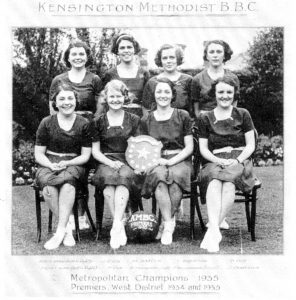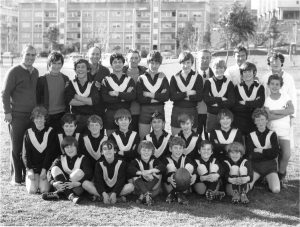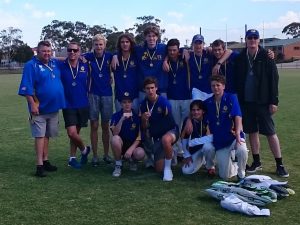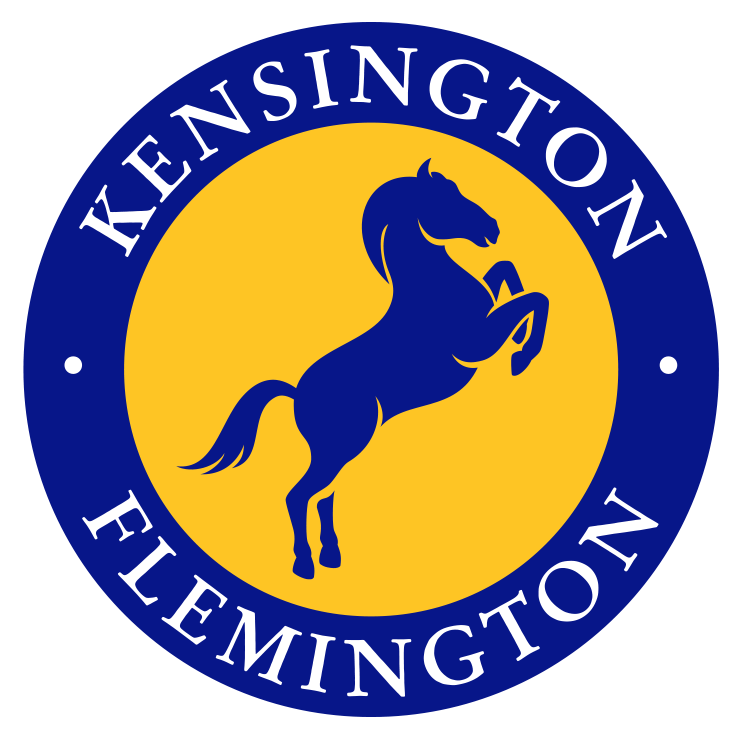KFJSC: A Potted History
The origins of the Kensington and Flemington Junior Sports Club can be traced back to 1882, when the Kensington Junior Cricket Club played its first season. By 1885/86 it was fielding first and second XI sides. Local football teams joined the Victorian Junior Football Association in the same decade – the Kensington Juniors in 1883 and Flemington Juniors in 1887.
The establishment of junior sport happened during a period of metropolitan–wide population and commercial growth. Kensington and Flemington, created as a borough in 1882, saw its population grow from 1,800 in 1883 to 9,000 by the end of the decade; many of the residents worked at the Newmarket cattle saleyards and abattoirs. The pastoral association was evident in the choice for the cricket and football club get-togethers. Lacking club houses and home grounds, the annual meetings were held at the Racecourse and Pastoral hotels on Racecourse Road, the choice also of the senior football and cricket clubs. An early patron of the Kensington Cricket Club, formed in 1878, was local MLA and future prime minister Alfred Deakin who was instrumental in securing the triangular parcel of land at the western end of Racecourse Road as a recreational reserve, known as Newmarket Reserve from 1886. Until then, senior and junior cricket and footy was played on local paddocks, including one behind the Pastoral Hotel which, the cricketers admitted, was a decent pitch but not of a turf standard. From 1892, lawn bowls and lawn tennis were played at Newmarket Reserve. From 1905, not long after the Victorian Ladies Cricket Association was formed, the Kensington and Flemington Ladies Cricket Club started playing at Newmarket Reserve.
A combined Flemington and Kensington junior football team emerged in the 1890s, which became one of the original eight teams in the Essendon District Football League [EDFL], itself formed in 1930. VFL clubs recruited local juniors; well-known names included rover Syd Dyer who played for North Melbourne Football Club. The ‘Shinboners’ had a close association with Ken-Flem, not only recruiting players but providing guernseys and footballs to local teams. In the 1930s, a Kensington Juniors team played in the Victorian Junior Football League [VJFL], winning back to back premierships in 1938 (B grade) and 1939 (A grade). Another local team which enjoyed success in the VJFL was the South Kensington Football Club, which played at the South Kensington Ground. South Kensington had a meteoric career: formed in 1930 and sponsored by local bookmaker Harry Youlden, it won the Metropolitan Junior League A grade flag three years running (1932-34) before folding in the late 1930s after Youlden’s death. Youlden was president of many local sport clubs and a generous benefactor of local sport, especially during the 1930s Depression years when many families felt the pinch of adversity. His name lives on in the Youlden Parkville Cricket Club. Formed in 1921 as Youlden’s Kensington Cricket Club, with men’s, ladies and junior teams, it became known as Youlden Parkville when the Kensington association was formally dropped in the early 1970s.
A combined Flemington Kensington Junior Cricket Club also emerged in the 1890s. Known as the Colts, it won the Metropolitan Matting Association Premiership in 1902/3 and turf premierships in the Victoria Junior Cricket Association in 1923/24, 1933/34, 1935/36 and 1936/37. The club’s backbone was the Smith family, whose father Charles and four sons Cecil, Jim, Les and Roy played junior and senior cricket with distinction and served administrative roles in the VJCA. The Colts continued to field sides in the post-WWII period in the in the VJCA turf and matting competitions. Cricket continues to be played at Newmarket Reserve in the 2000s with the Flemington Cricket Club, known as the Gulls.
Juniors were a part of many local sporting clubs, including the Flemington Athletics Club, Flemington Lacrosse Club and the Kensington and Flemington (men’s and women’s) amateur and professional cycling clubs. Olympian and world champion Sid Patterson started as a junior with the Kensington Amateur Cycling Club in the 1940s. Australian boxing champion Jack Carroll honed his skills as a youngster in the many boxing gyms in Kensington and Flemington (working class suburbs typically had boxing gyms); later champions included Graeme ‘Porky’ Brooke who won the Commonwealth lightweight title in 1984. Budding tennis stars played on the grass court at Newmarket Reserve, courts attached to local churches and, from the late 1930s, courts at the top of Smithfield Road built and funded by Melbourne City Council relief work for the local unemployed. After World War Two, when Greek and Italian migrants moved to Flemington and Kensington, soccer clubs like Kensington United were established.
Junior teams also emerged from the local churches. The Presbyterians and Methodists fielded tennis, netball, hockey, football, cricket and basketball teams in their own leagues as well as the suburban associations – Kensington Methodists was one of the original eight football teams in the EDFL. The Kensington Methodist Basketball Club (as netball was called until 1970) fielded teams in the Methodist Girls Basketball League, formed in 1932. Kensington Methodists won the 1934 and 1935 District premierships and were Metropolitan champions in 1935.

Kensington Methodist Girls Netball team, 1935.
Source: Beverley Wendelken, Kensington Methodists, Hotham Mission Uniting Church, 2001.
Kensington CYMS, Flemington CYMS (formed 1892) and St Brendan’s, Flemington, were the Catholic clubs. The Flemington football teams, which wore royal blue with a gold sash (now KFJSC colours), played at John Wren’s Ascot Vale pony racecourse and then Debney’s Park in Flemington after the Victorian Government purchased the racecourse for housing in the 1940s. The City of Melbourne bought Debney’s Paddock from the Debney family in 1941 and reserved it as a recreation ground, slowly turning it into a sporting field in the 1950s and 1960s as factories and tanneries were removed and the Flemington Housing Estate constructed. The CYMS football league was especially strong in Melbourne, fostering outstanding juniors like St Brendan’s Donald McDonald, who was recruited by the North Melbourne Football Club. McDonald was captain of the 1979 North Melbourne Colts U17 premiership team, which drew on St Brendan’s and Kensington locals. After the demise of the CYMS football league in the 1970s, St Brendan’s joined the NMFL (1975-79) and then the FDFL (WRFL from 2000) and rebuilt itself under president Steve Sabato (1977-84) and parishioners including Paul Mulgrew (FDFL Official of the Year 1984).
Other junior teams called J.J. Holland Park their home. The Park was named after long-serving local politician John Joseph Holland (1877-1955), Labor MLA for Flemington for 30 years from 1925, and representative for Hopetoun Ward on the Melbourne City Council for many years. He fought for better recreation facilities in the Ken-Flem area, denouncing proposals to develop the land into a pig market in the 1930s and a motor cycle speedway in the late 1940s. Holland Park was originally nicknamed South Kensington Swamp and Seagull Swamp due to its low-lying silty land prone to flooding. In the 1890s it was declared unfit for habitation and grazing purposes. However, the land became a much-needed additional sporting ground to Newmarket Reserve, weather permitting. Locals created several rough and ready ovals for winter and summer sport, although they had to contend with the area being used as a tip – teams would sometimes arrive at the ground and find landfill had been tipped onto cricket pitches overnight. Sport was also played on the north side of Kensington Road, below the Ridgeway, on Wight’s Paddock (now Kensington Banks), and on open land to the south of the South Kensington Station, until the Victorian Railways developed it in the 1940s. This area in general was known as the South Kensington Ground. The ‘lagoon’, near Ormond Street, doubled as the local swimming hole. There was a cinder track for the Kensington Amateur Cycling Club (opened 1935) at Wight’s Paddock, as well as a children’s playground built by the City of Melbourne in the late 1920s. Wight’s Paddock was lost when the City of Melbourne sold the land in World War II to the Department of the Army who built an Ordnance Depot there. After losing Wight’s Paddock and the land south of the train station, locals were alarmed when the proposal for a speedway was put to the City of Melbourne in 1947. Forming a protest committee, they pointed out that in fact fifteen sporting clubs and two local primary schools used the ‘swampy wasteland’ for recreational purposes. Should children be deprived of a playing ground? When the Victorian Housing Commission built the Holland Estate in the 1960s, Seagull Swamp was formally named J.J. Holland Park: the land was properly reclaimed, beautified, and a rubbish tip and skin drying store on Kensington Road removed. But until change rooms, storage facilities and toilets were built at Holland Park in the 1970s, local residents continued to provide facilities and did the ground preparation themselves.
A prominent and tireless volunteer associated with Holland Park was the late Bill Vanina, after whom the Holland Park pavilion is named. Vanina, who played junior football and cricket for the Flemington CYMS, was a life-long Ken-Flem resident; he never married, never drove a car, and worked in engineering factories in Melbourne’s north until he retired in the 1970’s. Vanina helped prepare the grounds, provide funds for the teams and used his Bellair Street house to store sporting gear. He summed up the Ken-Flem tradition of ‘giving the battlers a go’. During this period, a small number of boys from Turana Youth Training Centre played in the U17 football team; club helpers would collect and return the boys from Turana.
The Kensington Youth Club, founded by local parents in the late 1960s, fostered junior sport at Holland Park. The U13 boys football team was victorious in the 1972 grand final in the NDFL, while the U11s won the 1976 grand final. Local stalwarts included Stan and Bonnie Brown, Judy McRae and Brian Kane. In 1986, the North Melbourne and Kensington junior football teams joined forces, going on to win flags in the FDFL, including U15 in 1987, U13 in 1990 and U16 in 1997.

Kensington U13 junior football team, premiers 1972, photographed at Holland Park
Source: North Melbourne and Kensington Football Club Facebook page https://www.facebook.com/groups/170297423332106/
By 1990, St Brendan’s proud tradition came to an end, due to a declining club membership. Meanwhile, Flemington Junior Football Club, reborn in the 1980s, welcomed new players. Flemington Juniors won several flags in the 1990s in the FDFL, including U14C in 1991. In 2001 Flemington Juniors grasped an opportunity to move from Debney’s Park to superior facilities at Holland Park. The City of Melbourne significantly upgraded Holland Park: the park was redesigned, a BMX track and skate park created, synthetic oval installed and the Bill Vanina Pavilion built. In the 2000s, Flemington Juniors recruited strongly from local schools and from North Melbourne AusKick. In 2003 the U9s were restored; in 2004 the U14s; in 2005 the U16s, and 2018 the U17s. The Colts developed a strong reputation for good sportsmanship, achieved good results on the field (premierships in 2005, 2007, 2010, 2011, 2012 and 2016) and continued the local tradition in giving opportunities to underprivileged youth.
In 2003 with Rob Greenfield as president, the club perceived a need for a local community cricket club (Kensington Boys Cricket Club, established in the late 1960s, had folded in the 1990s) and again extended its activities, this time in the North West Metropolitan Cricket Association under the name of Kensington Junior Cricket Club. In its first year of its return to cricket the club entered eight teams at the U10, U12, U14 (with Reds CC) and U14 (girls); premiership success followed for both girls and boys teams. In addition, a Milo program for kids aged 5-8 years was introduced, and a pathway to senior cricket was put in place with the Flemington Colts Cricket Club, also located at Holland Park.

Kensington junior cricket team U17 Premiers 2016/17
With the rapid growth in the club it was felt that tighter management was required and in 2005 the club was re-incorporated as Kensington Flemington Junior Sports Club playing as Flemington Junior Football Club and Kensington Junior Cricket Club. Since then, KFJSC has added the Kensington Junior Girls Soccer Club (2007) and Kensington Junior Basketball Club (2009), both of which have won premierships (soccer U12 2013; basketball U14 & U16 & U18 2014/15, U18 2015/16, U16 2017/18). In 2017 the Kensington Junior Netball Club was added to KFJSC, and in 2018 boys soccer joined the club.
For over 130 years, KFJSC has worked hard to bring team sport to the area’s diverse communities who have made inner Melbourne their home. We remain a proud community based club run by parents where the main focus is on the all-round development of our young players. KFJSC enjoys world-class facilities at Holland Park, funded and maintained by the City of Melbourne.
Sources
Newspapers
Advocate, Age, Argus, Australasian, The Essendon gazette and Flemington spectator, Keilor, Bulla and Broadmeadows reporter, Flemington Spectator, Herald, Flemington-Kensington News, Leader, North Melbourne Advertiser, Sporting Globe, Sportsman, Weekly Times
Publications
Marcus Breen, People, Cows and Cars: The Changing Face of Flemington (1989)
Graeme Butler, Flemington and Kensington Conservation Study (1985)
Kevin Hillier, History of the WRFL/FDFL (2007)
John Stoward, History of Football in Melbourne’s North West: Essendon Football League, Western Region Football League (2008)
Websites
Boyle’s Football Photos http://www.boylesfootballphotos.net.au/article53-Photos-of-Thomas-Quinlan-Flemington-CYMS
Flemington Heritage Association https://www.facebook.com/flemingtonheritage/
Footypedia http://www.footypedia.com/
History of District Cricket http://premier.cricketvictoria.com.au/History.aspx?rw=c
Kensington Association http://www.kensingtonassociation.org.au/
Time Travellers sports teams (webpage hosted by local historian Lenore Frost) http://timetravellers.pbworks.com/w/browse/#view=ViewFolder¶m=Sports%20teams
North Melbourne and Kensington Football Club https://www.facebook.com/groups/170297423332106/
Youlden Parkville Cricket Club http://www.ypcc.org.au/content.aspx?file=437|10334d
Structure of KFJSC
